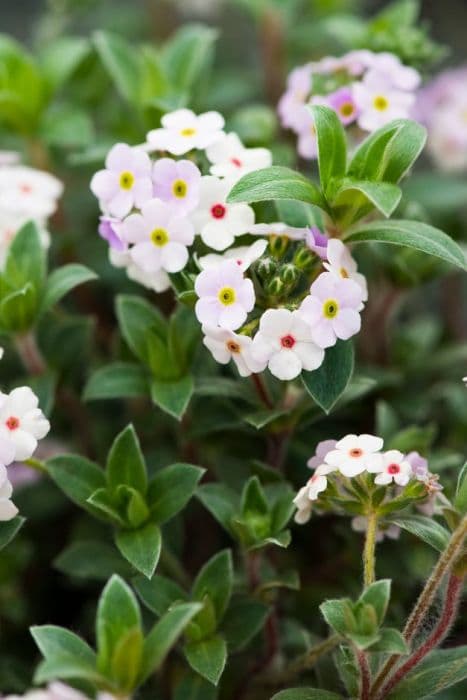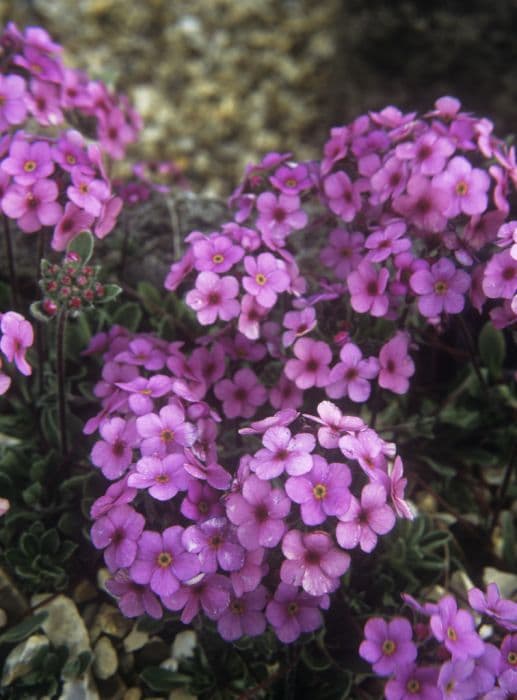Primrose Primula vulgaris 'Taigetos' (Pr/prim)

ABOUT
Primula vulgaris 'Taigetos', commonly known as the common primrose, is a plant with a charming appearance. It is characterized by a rosette of lush green, tongue-shaped leaves that form a pretty foliage mound. The leaves are somewhat wrinkled with a slightly jagged edge, giving them a textured look. Nestled among the leaves are the delightful flowers, which are truly the stars of the plant. These blossoms are typically light yellow with a darker yellow center, resembling a cheerful, sunny appearance that is often associated with the arrival of spring. The flowers have a classic primrose structure with five heart-shaped petals radiating from the central disc, exuding a delicate and captivating beauty. Each petal may also exhibit subtle hints of other colors, adding to its visual interest. The plant overall presents an inviting and fresh aspect to any garden setting, exuding a sense of new beginnings and natural charm.
About this plant
 Names
NamesFamily
Primulaceae
Synonyms
English Primrose, Common Primrose
Common names
Primula vulgaris 'Taigetos'
 Toxicity
ToxicityTo humans
Primrose is not considered highly toxic to humans, but it may cause mild stomach upset if ingested. Skin contact with the plant's sap may also result in dermatitis or irritation for those with sensitive skin or allergies.
To pets
Primrose is generally considered non-toxic to pets. However, as with any non-food plant, ingestion of large amounts could potentially cause mild gastrointestinal upset, such as vomiting or diarrhea, in some animals. It is always best to prevent pets from eating ornamental plants.
 Characteristics
CharacteristicsLife cycle
Perennials
Foliage type
Evergreen
Color of leaves
Green
Flower color
Yellow
Height
6 inches (15 cm)
Spread
6 inches (15 cm)
Plant type
Herb
Hardiness zones
5
Native area
Europe
Benefits
 General Benefits
General Benefits- Aesthetic Appeal: Adds bright and cheerful yellow flowers to gardens, which can enhance the visual appeal of any outdoor space.
- Easy to Grow: Known for being a hardy and low-maintenance plant, making it suitable for gardeners of all skill levels.
- Attracts Pollinators: The flowers of the English primrose attract butterflies and bees, supporting local ecosystems.
- Seasonal Interest: Blooms in early spring, providing one of the first splashes of color after winter.
- Ground Cover: Can be used as an effective ground cover due to its low-growing habit and tendency to spread.
- Erosion Control: Helps to prevent soil erosion, especially in shady areas where other plants might struggle to grow.
- Adaptability: Tolerates a range of soil types and pH levels as long as the soil is well-draining.
- Shade Tolerance: Prefers partial shade, making it an ideal choice for woodland gardens or shaded areas.
- Wildlife Habitat: Offers shelter and food for various insects, contributing to the biodiversity of the garden.
 Medical Properties
Medical Properties- This plant is not used for medical purposes.
 Air-purifying Qualities
Air-purifying QualitiesThis plant is not specifically known for air purifying qualities.
 Other Uses
Other Uses- Food Coloring: The bright colors of the Primrose petals can be used to naturally tint cakes and desserts.
- Edible Garnish: The flowers and leaves are edible and can provide a decorative element for salads and soups.
- Photography: Primroses are commonly used as subjects in botanical photography due to their vibrant and varied colors.
- Artistic Inspiration: The flowers serve as an inspiration for artists and are often depicted in paintings and fabric designs.
- Teaching Tool: The plant is used in educational settings to teach about plant biology and pollination processes.
- Dye Production: The flowers can be boiled to create a natural dye for fabrics or paper.
- Companion Planting: Primroses can be planted in vegetable gardens to attract beneficial insects.
- Eco-Friendly Confetti: Dried petals can serve as a biodegradable confetti alternative for celebrations.
- Fragrance Extraction: Their mild scent can be used to create delicate perfumes or to scent lotions and soaps.
- Culinary Experiments: The unique flavor of Primrose flowers is sometimes experimented with in avant-garde cuisine.
Interesting Facts
 Feng Shui
Feng ShuiThe Common Primrose is not used in Feng Shui practice.
 Zodiac Sign Compitability
Zodiac Sign CompitabilityThe Common Primrose is not used in astrology practice.
 Plant Symbolism
Plant Symbolism- Hope: As the primrose is often one of the first flowers to bloom in spring, it symbolizes hope and the return of happiness.
- Youth: The soft, delicate appearance of the primrose petals is reminiscent of youth and vitality, often invoking thoughts of youthfulness and new life.
- Renewal: Spring is a time for new beginnings, and the primrose, blooming at this time, represents renewal and the start of a new cycle.
- Love: In Victorian times, primroses were given as a symbol of young love and affection. Giving a primrose was a way to express that someone is your first love.
- Innocence: The primrose’s gentle appearance also associates it with purity and innocence, a common theme in floral symbolism.
 Water
WaterCommon primrose needs regular watering to maintain evenly moist soil, especially during its growing season in the spring. Water the plant when the top inch of soil feels dry, which may be approximately once a week depending on the environment. Avoid overwatering by ensuring the pot has good drainage and never let the plant sit in water. The amount of water may vary, but aim to provide about 8-16 ounces of water each time, adjusting as needed for your plant's size and environmental conditions.
 Light
LightCommon primrose thrives in bright, indirect light but can tolerate partial shade. It's best to place it in a location where it receives morning light and is shielded from the intense sun in the afternoon. Avoid exposing the common primrose to full sun, as this can scorch the leaves and fade the flowers.
 Temperature
TemperatureCommon primrose prefers cool to moderate temperatures, thriving between 50°F and 65°F. It can survive minimum temperatures down to about 32°F but should be protected from frost. Avoid placing common primrose in areas where temperatures exceed 80°F, as high heat can stress the plant.
 Pruning
PruningPrune common primrose to remove spent flowers and encourage a second blooming. Deadhead regularly by pinching off faded blooms at the base. In late summer or early fall, after blooming has finished, cut back foliage to rejuvenate the plant for the next season.
 Cleaning
CleaningAs needed
 Soil
SoilCommon primrose (Primula vulgaris 'Taigetos') thrives in moist, well-drained soil rich in organic matter with a pH between 6.0 and 7.0. A good soil mix would be one part garden loam, one part peat moss, and one part perlite or coarse sand to improve drainage. Regularly enriching the soil with compost will benefit the plant's growth and flowering.
 Repotting
RepottingCommon primroses like Primula vulgaris 'Taigetos' should be repotted every one to two years or when they outgrow their current container. Ensure to refresh the soil mix to provide adequate nutrients and space for root development.
 Humidity & Misting
Humidity & MistingCommon primrose prefers a humid environment within the range of 50-70% for optimal growth. Avoid placing the plant in overly dry conditions, which can stress it and lead to poor health and flowering.
 Suitable locations
Suitable locationsIndoor
Keep in bright, indirect light with moist soil.
Outdoor
Plant in partial shade with rich, moist soil.
Hardiness zone
4-8 USDA
 Life cycle
Life cycleThe Primula vulgaris 'Taigetos', commonly known as the English Primrose, begins its life cycle as a seed, typically germinating in cool, moist conditions in late winter to early spring. The seedlings develop into rosettes of leaves at the ground level, which can withstand winter cold. In the following spring, the plant enters the vegetative stage, with leaves growing larger and the root system becoming more established. As it reaches maturity, the English Primrose produces clusters of yellow flowers from early to mid-spring, attracting pollinators for sexual reproduction. After pollination, the flowers develop into capsules containing seeds, which are dispersed by various means, restarting the cycle. The plant is perennial, capable of surviving for several years, going dormant in the winter and re-sprouting from the same root system annually.
 Propogation
PropogationPropogation time
Spring-Early Summer
The most popular method for propagating Primula vulgaris 'Taigetos', commonly known as the English Primrose, is by division. This is typically done in late summer after flowering has finished or in early autumn. To propagate by division, carefully dig up the plant and gently separate the clump into smaller sections, ensuring that each section has a good amount of roots attached. These divisions should then be replanted immediately at the same depth they were growing before, spaced about 6 to 12 inches (15 to 30 centimeters) apart to allow for adequate growth. Water the new divisions well to help establish them. This method of propagation helps to rejuvenate older plants while also increasing the number of plants in your garden.









